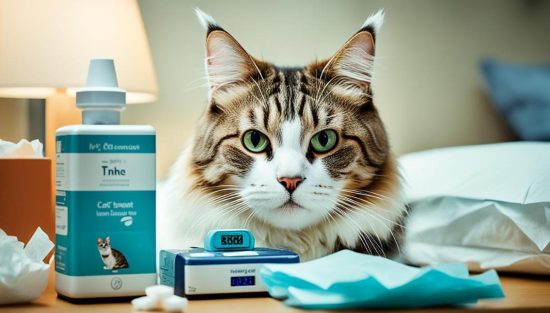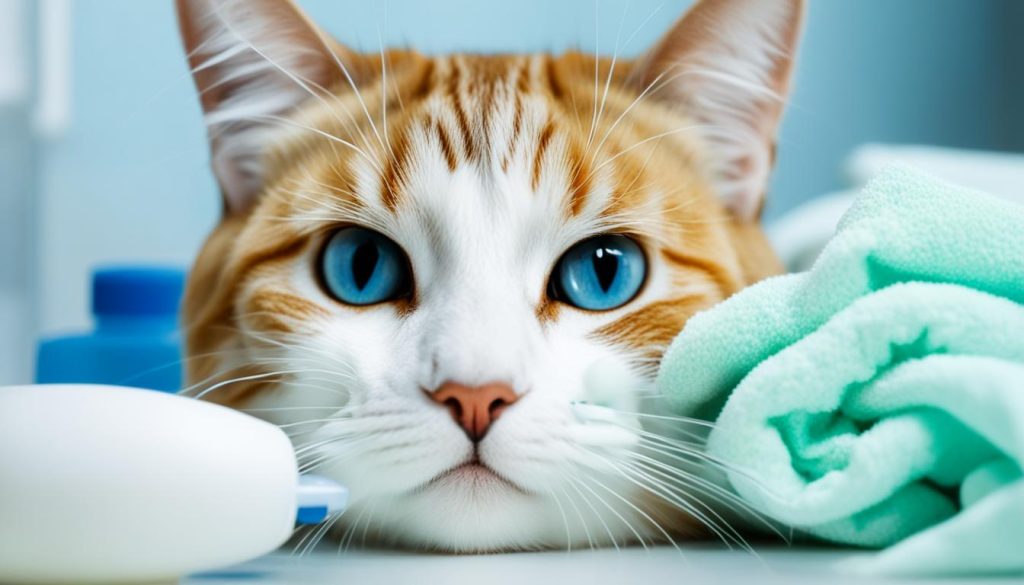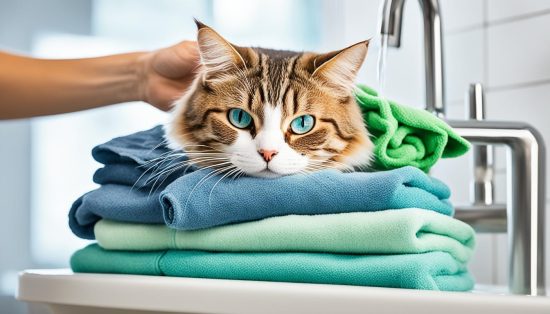How Can I Tell If My Cat Has a Fever? Signs & Symptoms
Discover the key signs of fever in cats and learn how to detect if your feline friend is running a temperature with our helpful guide.

Did you know that cats can run a temperature, just like humans? Cats with a fever may exhibit signs such as loss of appetite, depression, lack of energy, decreased drinking, hiding, decreased grooming, shivering, and rapid breathing. These are all potential indicators that your feline friend may be running a temperature.
But how can i tell if my cat has a fever? The most accurate method is by taking their temperature using a pediatric rectal thermometer. While it may sound challenging, don’t worry, we’ll guide you through the process. A normal temperature in cats ranges from 100.4º to 102.5º Fahrenheit. If your cat’s temperature rises above 102.5º F, it is considered a fever. Fevers in cats can be caused by infections, injuries, certain medications, tumors, or diseases such as lupus.
It’s important to note that fevers can actually be beneficial in fighting off disease. However, if your cat’s temperature reaches above 106º F, it can cause organ damage and requires immediate veterinary attention. In the following sections, we’ll show you how to check your cat’s fever at home, common signs of fever in cats to look out for, and when it’s time to seek veterinary care. Let’s ensure your feline companion stays healthy and happy!
How to Check Your Cat’s Fever at Home
Checking your cat’s fever at home can help you determine if they need veterinary care or if their symptoms can be managed with home remedies. With the right supplies and a gentle approach, you can accurately measure your cat’s temperature. Here’s how:
- To check your cat’s temperature, you’ll need a digital thermometer or a pediatric rectal thermometer, petroleum jelly as a lubricant, alcohol, and a paper towel for cleaning the thermometer.
- Find a calm and quiet space for the temperature check. Have a cat treat on hand to reward your cat afterward.
- Gently lift your cat’s tail, exposing the rectal area. If using a digital thermometer, turn it on and follow the manufacturer’s instructions to ensure proper use. If using a pediatric rectal thermometer, apply a small amount of petroleum jelly to the tip to ease insertion.
- Carefully insert the thermometer into your cat’s anus. Be gentle and avoid causing any discomfort or harm.
- Leave the digital thermometer in place until it beeps. For a glass thermometer, hold it in position for about two minutes.
- Once you have the reading, carefully remove the thermometer. Clean it with alcohol and a paper towel or follow the manufacturer’s cleaning instructions.
Remember to provide your cat with comfort and reassurance throughout the process. If you’re unsure about taking your cat’s temperature or if your cat becomes distressed, it’s best to seek veterinary assistance for a professional evaluation.
How can I tell if my cat has a fever?
When your cat is feeling unwell, it’s important to be able to recognize the signs and symptoms of a fever. Fever symptoms in cats can vary, but there are some common indicators to look out for that may suggest your furry friend is running a temperature. One of the first signs you may notice is warm ears. Cats’ ears play a role in their body’s cooling process, so if they feel unusually warm to the touch, it could be a sign of a fever. Additionally, a dry nose that is excessively dry or hot to the touch can also indicate a fever. Lethargy and a lack of energy are common symptoms of fever in cats. If your cat seems unusually tired, weak, or disinterested in their usual activities, it may be a sign that they have a fever. Loss of appetite is another potential symptom to look out for.
If your cat has little to no interest in food, particularly if it persists along with other symptoms, it could be an indication of a fever. Glassy eyes can be another symptom of fever in cats. While cats’ eyes naturally have a certain shine to them, if their eyes appear red, watery, or sunken, it may be a sign that they have a fever. Keep an eye out for any changes in the appearance of your cat’s eyes.
Measuring Body Temperature

A cat’s normal body temperature typically ranges from 100.5 to 102.5 degrees Fahrenheit, and a temperature higher than 103.5 degrees Fahrenheit is considered a high fever in cats. If you suspect your cat may have a fever, it’s important to monitor their temperature using a reliable and accurate thermometer. By measuring their body temperature, you can have a better understanding of whether or not they are running a fever.
Remember, if you believe your cat has a fever, it’s always best to consult with a veterinarian for a proper diagnosis and guidance on the appropriate course of action.
Treating a Cat with a Fever
If your cat is experiencing a fever that lasts for more than 24 hours or has a high fever exceeding 104º F, it is crucial to seek immediate veterinary care. A qualified veterinarian will conduct comprehensive tests to determine the underlying cause of the fever and develop an effective treatment plan tailored to your cat’s specific needs.
In cases where the fever is caused by a bacterial infection, the veterinarian may prescribe antibiotics as part of the treatment to combat the underlying infection. It is essential to administer the prescribed medication as instructed by the veterinarian to ensure optimal effectiveness and overall well-being of your cat. Remember, certain medications, like acetaminophen, can be toxic to cats, so it is vital to consult with a veterinarian before administering any over-the-counter medications.
In addition to medication, your cat may require fluids if they are experiencing moderate to severe dehydration due to the fever. The administration of fluids can help restore hydration and support your cat’s recovery process. The veterinarian will closely monitor your cat’s condition and adjust the fluid therapy as needed to ensure adequate hydration.

Common Treatment Approaches for Cat Fever
| Treatment | Description |
|---|---|
| Antibiotics | Prescribed to combat bacterial infections causing the fever |
| Fluid Therapy | Administered to address dehydration and support recovery |
| Temperature Monitoring | Regular monitoring of body temperature to evaluate progress |
| Underlying Cause Treatment | Treatment targeting the specific underlying cause of the fever |
| Supportive Care | Providing comfort and supportive measures to aid recovery |
Your veterinarian will guide you through the treatment process, providing comprehensive care for your cat to help them recover from the fever efficiently. It is crucial to follow the veterinarian’s instructions diligently and keep them informed about any changes or developments in your cat’s condition.
When to Seek Veterinary Care for a Cat with a Fever?
If your cat’s fever lasts longer than 24 hours or reaches high temperatures, it is important to seek veterinary care. A cat fever emergency can be a sign of an underlying condition that requires immediate attention. A fever in cats that exceeds 106º F can lead to organ damage and requires emergency vet for cat fever.
Monitoring your cat’s behavior is crucial. If your cat shows signs of dehydration, such as decreased water intake or sunken eyes, it is vital to consult a veterinarian. Additionally, if the fever is accompanied by other concerning symptoms, like vomiting or diarrhea, it is crucial to seek veterinary care for your cat’s well-being.
When you take your cat to the veterinary clinic, the veterinarian will conduct a thorough examination to determine the underlying cause of the fever. This veterinary care will involve tests to identify any infections, injuries, or diseases contributing to the fever. Based on the diagnosis, the veterinarian will develop a personalized treatment plan, which may include fever in cats veterinary care, the administration of medication, or intravenous fluids to address dehydration.
FAQs on how can i tell if my cat has a fever
What are the symptoms of fever in cats?
Cats with a fever may exhibit signs such as loss of appetite, depression, lack of energy, decreased drinking, hiding, decreased grooming, shivering, and rapid breathing.
How can I check my cat’s fever at home?
To check your cat’s fever at home, you can use a digital thermometer or a pediatric rectal thermometer. Gently lift your cat’s tail and insert the thermometer into their anus. Leave the digital thermometer in place until it beeps, or a glass thermometer for about two minutes. Clean the thermometer with alcohol and read the temperature.
Can you tell if a cat has a fever by their ears?
Warm ears can indicate a fever because a cat’s ears contribute to their body’s cooling process.
What can I give my cat for a fever?
It is crucial not to give your cat any medication without the advice of a veterinarian, as certain medications, like acetaminophen, can be toxic to cats.
Can a cat’s fever go away on its own?
Fevers can be beneficial in fighting disease, but a high fever above 106º F can cause organ damage and requires immediate veterinary attention.
Can a cat recover from fever without medicine?
If your cat’s fever lasts longer than 24 hours or reaches high temperatures, it is important to seek veterinary care. The veterinarian will determine the underlying cause of the fever and develop an appropriate treatment plan.






